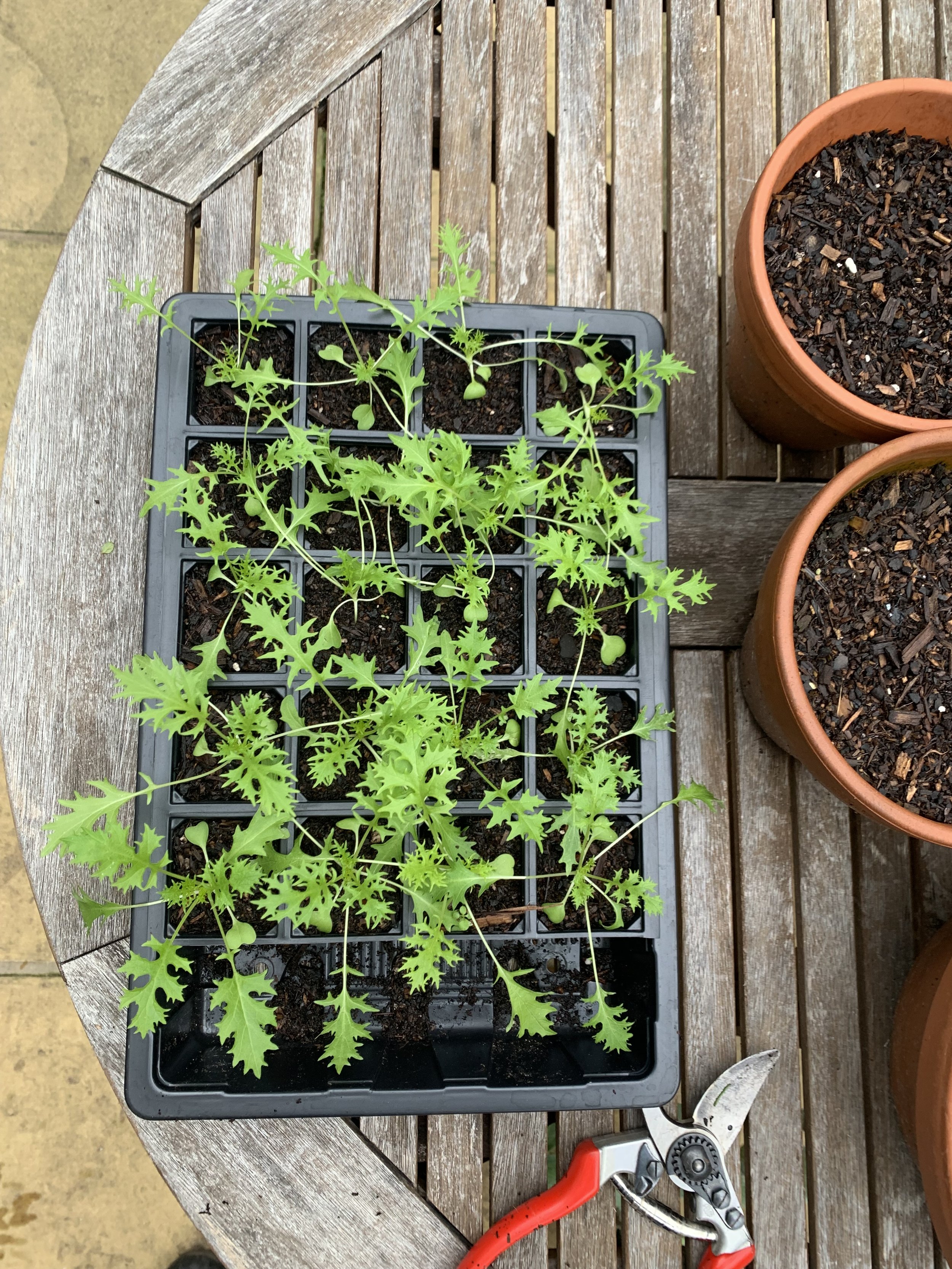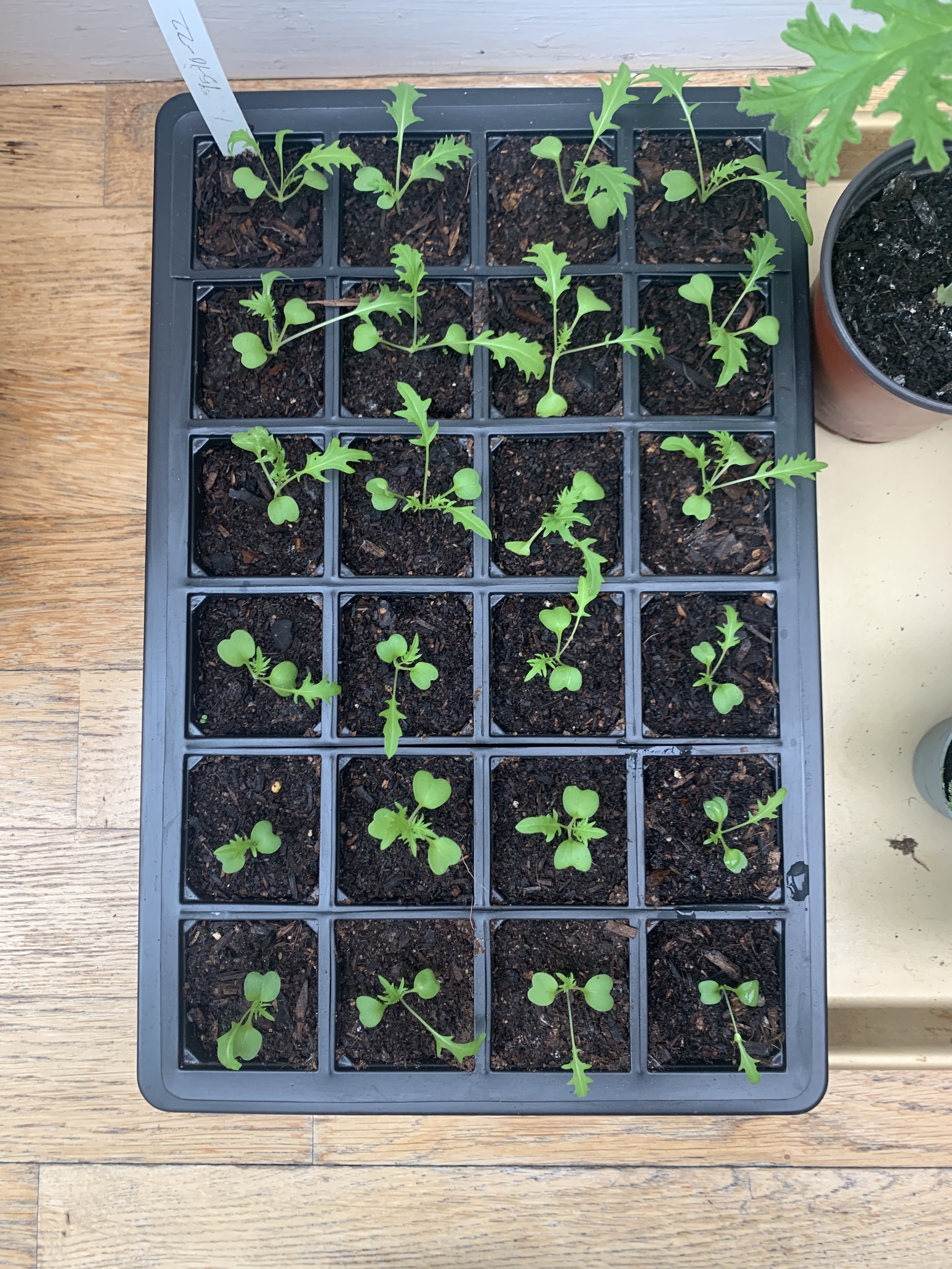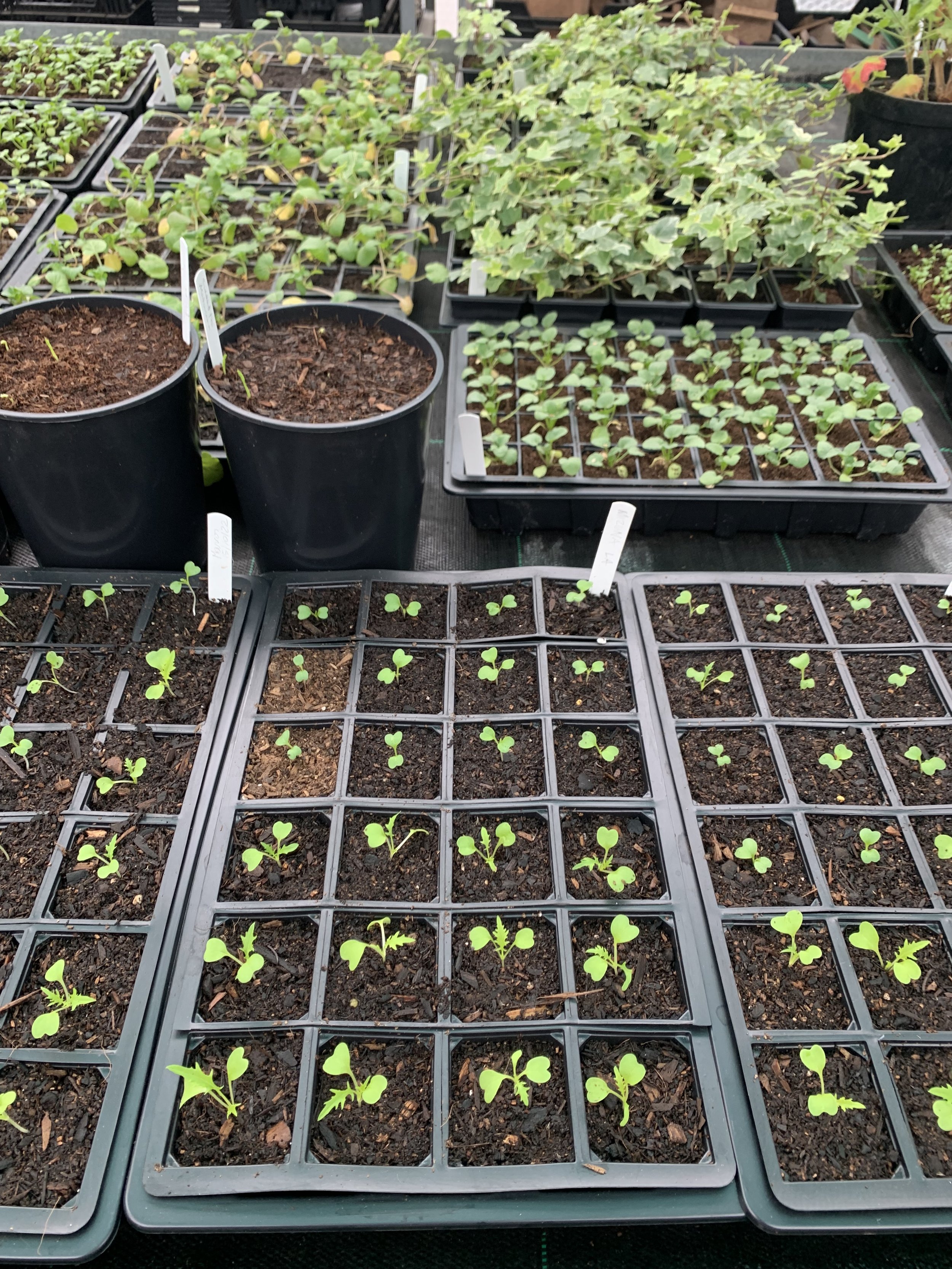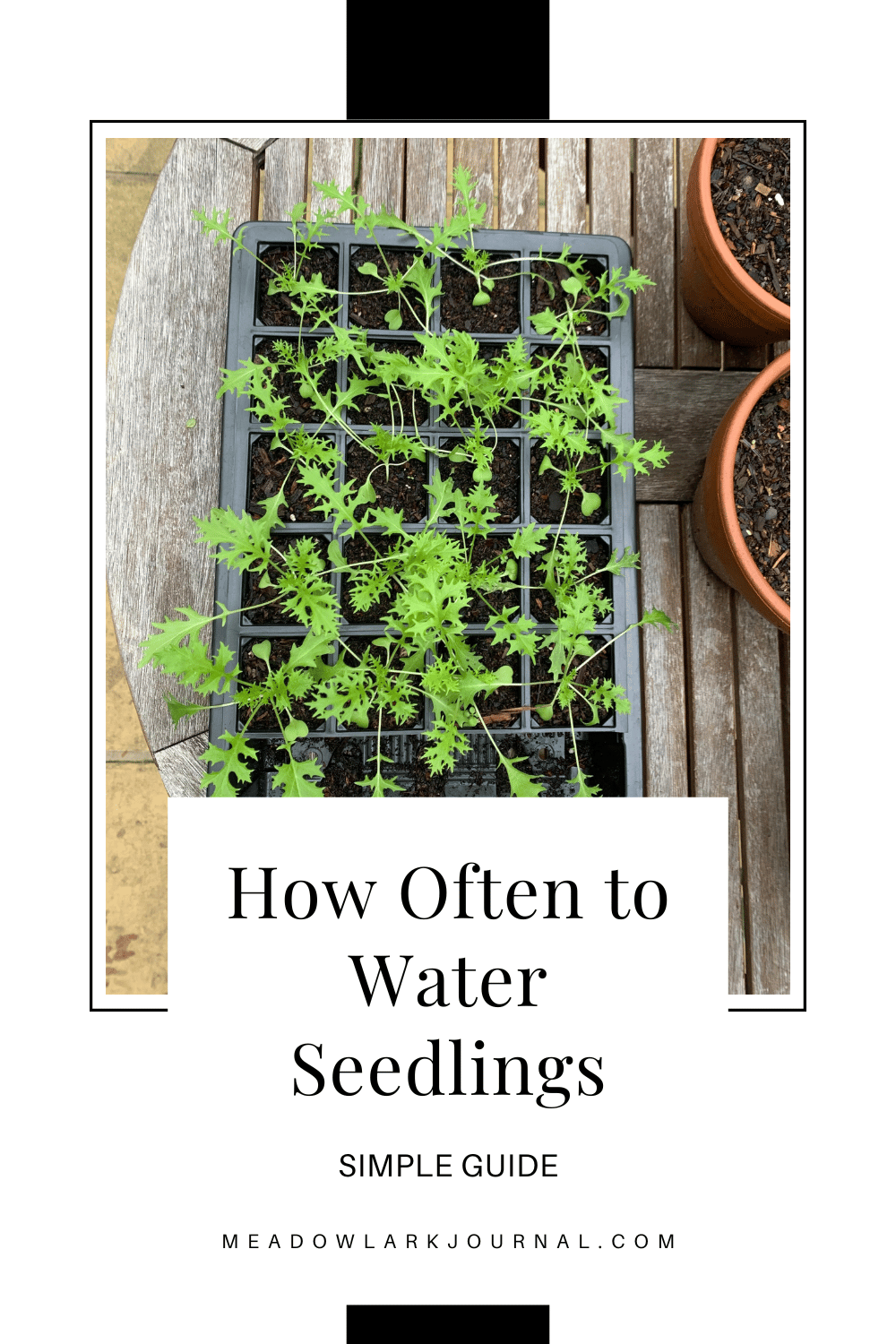How Often to Water Seedlings
This website is reader-supported - thank you! This post may contain affiliate links. As an Amazon Associate, I earn from qualifying purchases at no extra cost to you.
As you prepare to transform tiny seeds into flourishing plants, understanding the nuances of watering becomes essential.
In this guide, we'll unravel the mysteries of watering seedlings, ensuring your green friends receive the care they need to thrive.
Whether you're nurturing seedlings indoors, in a greenhouse, or in your garden, getting the watering right is a critical step on the path to healthy plant life.
For more watering tips, check out my guides:
My tiny arugula seedlings after watering.
To learn more about growing from seed, check out my guides:
Understanding Your Seed Starting Mix
When embarking on your seed starting journey, one of the first and most crucial decisions involves selecting the right starting mix.
This mix is not just soil—it's the foundation for your seedlings' growth.
To learn more, check out my guide: The Best Seed Starting Mix.
Here's what you need to know:
The Role of a Good Starting Mix
A starting mix serves several critical functions:
Support:
It physically supports the seed, holding it in place.
Moisture:
It retains moisture efficiently, keeping the seed hydrated.
Aeration:
It provides enough air space to allow roots to breathe and grow.
Choosing the Right Mix
Coco Coir Mixes:
Made from coconut husks, coco coir is a sustainable alternative to peat moss.
It’s excellent at retaining moisture and is pH neutral, making it suitable for a wide range of seed types.
Other Components:
Some mixes include vermiculite or perlite to enhance aeration and moisture retention.
These additions can be particularly helpful in maintaining the delicate balance needed for seed germination.
To learn more, check out my guide: Perlite vs Vermiculite: What's Best for Your Garden?
Peat Moss-Based Mixes:
Avoiding peat-based mixes for your seed starting mix is important due to environmental concerns.
Peat bogs, where peat moss is harvested, are critical ecosystems that act as carbon sinks, and their depletion contributes to climate change and biodiversity loss.
Additionally, peat bogs take centuries to regenerate, making peat an unsustainable resource for gardening purposes.
Customizing Your Mix
For Moisture-Loving Seeds:
If you’re starting seeds that thrive in moist conditions, consider a mix with coco coir content.
For Seeds Needing More Drainage:
For seeds that prefer drier conditions, increase the proportion of perlite or vermiculite in your mix.
Preparing Your Starting Mix
Before you sow your seeds, moisten the mix.
It should feel like a wrung-out sponge—not dripping wet but uniformly damp.
If it’s too dry, your seeds won’t germinate effectively.
Too wet, and you risk mold growth and root rot.
The Importance of pH
While most starting mixes are designed to be pH neutral, it’s worth checking if you’re growing a plant that’s particularly sensitive to soil pH.
Adjusting the pH, if necessary, can be done using lime (to increase pH) or sulfur (to decrease pH).
Sterilization: Pros and Cons
Some gardeners prefer to use sterilized seed starting mixes to prevent disease.
While this can be beneficial in preventing mold or fungus, it also means the mix lacks beneficial microorganisms.
It's a balance between protecting your seedlings and promoting a natural growing environment.
My recommend pick for a seed starting mix:
For more growing tips, check out my guides:
The First Steps: Watering Seeds and Seedlings
Embarking on your seed starting adventure involves more than just planting; it's about nurturing your seeds and seedlings with the right amount of water.
This stage is delicate and requires a keen eye and gentle hand.
Here's a deeper dive into how to do it right.
Seed Germination: Watering the Right Way
Initial Moisture is Key:
When you first plant your seeds, ensure the starting mix is evenly moist.
This moisture is crucial for activating the germination process.
Consistency Matters:
Keep the soil consistently moist but not waterlogged.
Check daily, as the top layer can dry out quickly, especially in warm, dry conditions.
The Gentle Touch:
Use a spray bottle to gently mist the soil.
This method prevents the force of water from moving or unearthing the seeds.
A light touch is essential during this early stage.
Here is the spray bottle I recommend for this:
Monitoring Moisture Levels
Visual Checks:
Look for signs of dryness on the surface.
If the soil looks dry, it's time to water.
Physical Checks:
Feel the soil.
The top inch should be moist.
If it feels dry, your seeds need water.
The Weight Test:
Pick up the seed tray or pot.
If it feels light, it's likely that the soil is dry and needs water.
Seedlings’ First Drink
Transitioning from Mist to Watering:
As your seeds sprout and seedlings emerge, they'll need more water.
Transition from misting to gentle watering.
Be cautious not to disturb the fragile new roots.
Watering Frequency:
Young seedlings generally need water every 1-3 days.
However, this can vary based on the environment and the type of plant.
Avoiding Common Pitfalls:
Overwatering can be as harmful as underwatering.
Ensure that your seedling trays or pots have good drainage to prevent water accumulation at the bottom.
Nurturing Your Growing Seedlings
Encouraging Strong Roots:
Once your seedlings have established themselves, watering from the bottom can encourage deeper root growth.
Place the tray or pots in a shallow water container, allowing the water to be absorbed from the bottom.
Observing Your Seedlings:
Look for signs of distress.
If seedlings are wilting, yellowing, or appear stunted, reassess your watering routine.
Adapting to Environmental Changes
Indoor vs Outdoor Conditions:
Seedlings grown indoors may have different watering needs than those grown outdoors.
Indoor environments tend to be drier, especially in homes with central heating or air conditioning.
Light and Heat:
Seedlings in direct sunlight or in warmer environments may need more frequent watering.
Conversely, those in cooler, shaded areas may require less.
My recommended pick for seed starting trays:
For more watering tips, check out my guides:
To make growing from seed easier, check out my guide:
The Ultimate Guide to Choosing the Best Electric Propagators
Routine Matters: How Often to Water
Finding the right watering routine is crucial for the health of your seedlings.
It's a balancing act that depends on various factors such as the environment, type of plants, and growth stage.
Let’s break down these elements to understand the best practices for watering frequency.
Understanding Seedlings' Water Needs
Growth Stage:
Younger seedlings need more frequent but less heavy watering.
As they grow, their root systems develop, and they can handle more water less often.
Type of Plants:
Different plants have varying water needs.
Seedlings of moisture-loving plants like lettuce may require more frequent watering compared to those of drought-tolerant species like lavender.
Indoor Watering
Frequency:
Indoor seedlings generally need water every 2-3 days.
However, this can vary based on factors like air humidity, temperature, and light exposure.
Monitoring:
Keep an eye on the moisture level of the soil.
Indoor heating systems can dry out the air and soil quickly, necessitating more frequent watering.
Greenhouse Watering
Daily Check-In:
In a greenhouse setting, you might need to water your seedlings once a day, especially in warm and sunny conditions.
Environmental Control:
Greenhouses can create microclimates with higher humidity and temperature, which can accelerate soil drying.
Regular monitoring is key.
To learn more about growing in greenhouses, check out my guide How Does a Greenhouse Work?
Garden Watering
Adapting to Weather:
Outdoor seedlings' watering needs largely depend on the weather.
During hot, dry periods, daily watering may be necessary.
In cooler, cloudier conditions, less frequent watering is required.
Morning Routine:
Watering in the early morning is ideal, as it allows water to soak into the soil before the heat of the day and reduces evaporation.
Watering Seedlings in Different Containers
Pots and Trays:
Containers often dry out faster than garden soil.
Check them daily and water when the top inch of soil feels dry.
Size Matters:
Smaller containers dry out faster than larger ones.
Adjust your watering frequency based on the size of your pots or trays.
Watering Techniques
Bottom Watering:
As seedlings grow, consider bottom watering.
This technique encourages deeper root growth and helps prevent overwatering.
Top Watering:
For young seedlings, gentle top watering with a watering can or spray bottle is effective.
Ensure the water is distributed evenly across the soil.
Special Cases
Hydroponic Systems:
For seedlings in hydroponic systems, maintaining the right water level and nutrient balance is critical.
Monitor the system regularly.
Drought Conditions:
In areas with water restrictions or drought conditions, consider using water-conserving methods like drip irrigation or self-watering seedling trays.
To learn more about growing from seed, check out my guide:
For more tips, check out my guide:
FAQs
How often should I water my vegetable seedlings?
The frequency of watering vegetable seedlings can vary depending on factors like the type of vegetable, the size of the seedlings, the climate, and the type of soil or growing medium.
Generally, vegetable seedlings require watering every 1-2 days.
It's essential to check the soil moisture; it should be moist but not waterlogged.
In hotter or drier climates, or under intense grow lights, you may need to water more frequently.
Conversely, in cooler or more humid conditions, less frequent watering might be needed.
Consistent monitoring and adjusting based on the seedlings' responses is key.
Can I overwater my seedlings?
Yes, overwatering is a common issue when growing seedlings.
It can lead to a lack of oxygen in the soil, which in turn can cause root rot and fungal diseases.
Signs of overwatering include yellowing leaves, stunted growth, and a general appearance of wilting or 'sogginess'.
Ensure your pots or trays have proper drainage and avoid letting the seedlings sit in standing water.
Allow the top layer of soil to dry out slightly between waterings.
This practice encourages deeper root growth and helps prevent overwatering.
Should I use room temperature water for my seedlings?
Using room temperature water is generally recommended for watering seedlings.
Water that is too cold can shock the delicate root systems of young plants, potentially slowing their growth or causing damage.
On the other hand, hot water can harm the roots and may also increase the risk of fungal diseases.
Room temperature water is more conducive to healthy root development and overall plant health.
Is misting a good way to water my seedlings?
Misting can be an effective way to water seedlings, especially in the earliest stages of growth when they are most delicate.
A fine mist helps keep the soil evenly moist without disturbing the seeds or causing erosion in the soil.
However, as seedlings grow and their water needs increase, misting alone may not provide enough moisture, and more thorough watering methods will be necessary.
It's important to transition to watering methods that ensure deeper moisture penetration as the plants develop.
How do I know if I'm watering my seedlings enough?
To determine if you are watering your seedlings enough, regularly check the moisture level of the soil.
The soil should be consistently moist but not waterlogged.
Seedlings that are not receiving enough water may exhibit signs like drooping, wilting, or browning at the leaf edges.
Conversely, overwatered seedlings might show yellowing leaves, a general appearance of limpness, or even mold growth on the soil surface.
Adjust your watering routine based on these observations and aim for a balance where the soil remains evenly moist.
Wrap-Up
Starting seeds indoors is an exciting venture that paves the way for the emergence of true leaves, signaling a new phase in your plant's journey.
The use of seed trays has been instrumental in this process, offering a controlled environment for your seedlings to flourish.
Remember, proper drainage holes in these trays or pots are vital.
They ensure that excess water doesn't accumulate, thereby protecting your delicate seedlings from the risks of waterlogging.
This is especially important for indoor plants, which depend on us for their every need, from light to water to nutrients.
The art of watering seedlings is a blend of science and intuition.
It's about understanding the needs of your plants at each stage of their growth, from the first sprout to the development of true leaves, and adjusting your care to suit these needs.
Embrace the journey with patience and you'll be rewarded with the lush greenery of healthy plants.
Equip your urban green space with my recommend top tier tools.
Pin this post to save it for later!





































